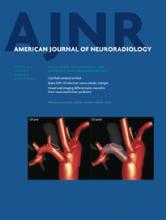In their paper entitled “Generalized versus Patient-Specific Inflow Boundary Conditions in Computational Fluid Dynamics Simulations of Cerebral Aneurysmal Hemodynamics,” Jansen et al1 compare results from computational fluid dynamics (CFD) simulations performed with 2 different kinds of boundary conditions: a spatiotemporal inflow waveform measured with 2D phase-contrast MR imaging in the individual patient and a generalized inflow velocity profile previously described in the literature. In their comparison, Jansen et al focus on wall shear stress (WSS) and, derived from it, the oscillatory shear index as well as intra-aneurysmal flow patterns. In agreement with previously published results,2⇓⇓–5 they report statistically significant differences for the 2 approaches.
Simulating hemodynamics in cerebral aneurysms with CFD techniques is a relatively new approach translating a well-established engineering technology into clinical research. Essentially, a computational model as an approximation of the real world is created and the governing equations for blood flow (Navier Stokes equations) are numerically solved based on this mathematic construct. The output of these simulations includes the velocity fields and the values of other hemodynamic parameters such as WSS or pressure.
The fidelity of the results depends on the kinds of approximations or simplifications made when creating the computational model. For instance, early simulations using 2D models with simple geometric approximations were able to demonstrate low WSS at the aneurysm dome6; however, because of inherent limitations, these models could not provide any information about the 3D distribution of the flow or WSS. In many studies to date, 3D volumetric information derived from medical image data specific to the individual patient is used, often from 3D digital subtraction angiography but also from CT angiography or MR angiography. Boundary conditions are approximated by generalized waveforms. These simulations succeed in providing a true 3D description of the spatial and temporal distributions of hemodynamic parameters. As there are no variations in the inflow boundary condition, differences in the simulation results between individual aneurysms originate from the aneurysm geometries alone. With this approach it was demonstrated that CFD can visualize and quantify hemodynamic differences between ruptured and unruptured aneurysms.7⇓–9
As Jansen et al1 demonstrate, simulations may be further refined by incorporating patient-derived flow information into the model as the exact shape of the inflow waveform may exert significant effects on at least some of the calculated hemodynamic parameters. However, physiologic waveforms may also vary. For instance, intense physical efforts or emotional excitement typically result in a sudden change in heart rate and blood pressure. A CFD study investigating the effects of increase in cardiac frequency found significant changes in the overall intra-aneurysmal flow patterns (eg, vortex formation and translation) and an increase in WSS.10 These effects may also need to be considered for an accurate assessment of hemodynamics in cerebral aneurysms with CFD techniques.
CFD simulations are the results of mathematic constructs and validation of their results is necessary. Validation studies comparing virtual angiograms (derived from CFD) with acquired angiograms11⇓⇓–14 and comparing simulated intra-aneurysmal flow patterns with those measured with 2D phase-contrast MR imaging15⇓⇓–18 or 4D phase-contrast MR imaging19,20 reported generally good agreement and thereby encourage the continued advancement of CFD. Still, a better understanding of the limitations of CFD simulations is warranted.21⇓–23
Computational simulations will play an increased role in the future for enhancing and complementing the information in medical images. Furthermore, such simulations will not be limited to studies of hemodynamics in cerebral aneurysms. As an indicative example, CFD studies have been recently performed for investigating CSF flow in Chiari malformations.24,25 Further validation and optimization of CFD techniques as well as streamlining the simulation process itself, eg, by using dedicated CFD simulation and visualization systems,26 may foster further integration of this exciting technology into clinical research.
REFERENCES
- © 2014 by American Journal of Neuroradiology







